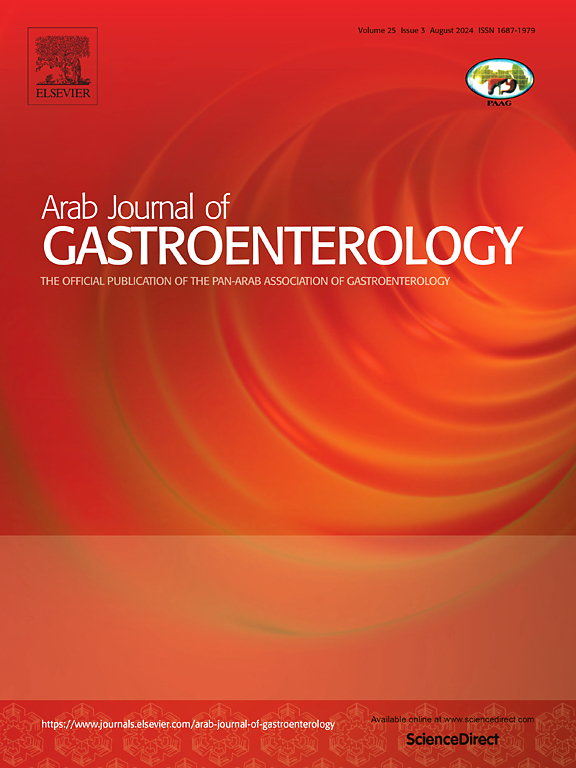Clinical efficacy of phenobarbital combined with ursodeoxycholic acid in the treatment of neonatal patients with cholestasis
IF 1.1
4区 医学
Q4 GASTROENTEROLOGY & HEPATOLOGY
引用次数: 0
Abstract
Background and study aims
The aim of this study was to explore and evaluate the clinical effect of phenobarbital combined with ursodeoxycholic acid in the treatment of neonatal cholestasis.
Patients and methods
100 infants were divided into two groups using the random number method, with 50 cases in each group. The PB group was given routine treatment and phenobarbital, and the combination group received the same treatment as the PB group and was additionally given ursodeoxycholic acid. Observe the liver function indicators (γ-glutaminyl transferase (γ-GGT), aspartate transferase (AST), and alanine aminotransferase (ALT)), serum bilirubin (the total bilirubin (TBIL), and direct bilirubin (DBIL)), total effective rate and adverse reactions of the children.
Results
After treatment, the levels of γ-GGT, AST, ALT DBIL, and TBIL in both groups of children were reduced (P < 0.01). the jaundice index of children in the combination group was clearly reduced (P < 0.05) and was obviously lower than that of the PB group (P < 0.05). Moreover, children in the combination group had more daily defecation times than the PB group, and the time to first discharge and yellowing of meconium was shorter than that in the PB group (P < 0. 05). The total effective rate of treatment in the combination group was obviously higher than that in the PB group (94.00 % VS. 78.00 %, P < 0.05), and the average time for complete resolution of jaundice also was shorter than that in the PB group (P < 0.05). A few children develop diarrhea, which occasionally causes skin itching, rash, and other adverse reactions, but most of them are mild and will not affect the treatment effect or prognosis.
Conclusion
Phenobarbital combined with ursodeoxycholic acid can improve the liver function of children to a greater extent in the treatment of neonatal cholestasis. It can also reduce serum bilirubin concentration, has good clinical efficacy, does not cause serious adverse reactions, and has good safety.
苯巴比妥联合熊脱氧胆酸治疗新生儿胆汁淤积症的临床疗效观察。
背景与研究目的:探讨并评价苯巴比妥联合熊去氧胆酸治疗新生儿胆汁淤积症的临床疗效。患者与方法:采用随机数字法将100例患儿分为两组,每组50例。PB组给予常规治疗和苯巴比妥治疗,联合用药组与PB组治疗相同,加用熊去氧胆酸治疗。观察患儿肝功能指标(γ-谷氨酰基转移酶(γ-GGT)、天冬氨酸转移酶(AST)、丙氨酸转氨酶(ALT))、血清胆红素(总胆红素(TBIL)、直接胆红素(DBIL))、总有效率及不良反应。结果:治疗后两组患儿γ-GGT、AST、ALT、DBIL、TBIL水平均降低(P)。结论:苯巴比妥联合熊去氧胆酸治疗新生儿胆汁淤积症能更大程度地改善患儿肝功能。还能降低血清胆红素浓度,临床疗效好,不发生严重不良反应,安全性好。
本文章由计算机程序翻译,如有差异,请以英文原文为准。
求助全文
约1分钟内获得全文
求助全文
来源期刊

Arab Journal of Gastroenterology
Medicine-Gastroenterology
CiteScore
2.70
自引率
0.00%
发文量
52
期刊介绍:
Arab Journal of Gastroenterology (AJG) publishes different studies related to the digestive system. It aims to be the foremost scientific peer reviewed journal encompassing diverse studies related to the digestive system and its disorders, and serving the Pan-Arab and wider community working on gastrointestinal disorders.
 求助内容:
求助内容: 应助结果提醒方式:
应助结果提醒方式:


